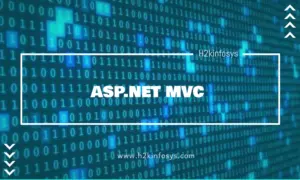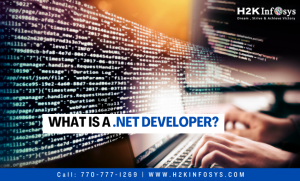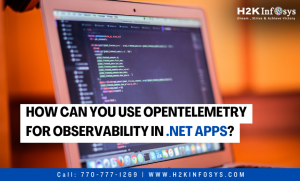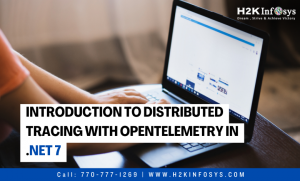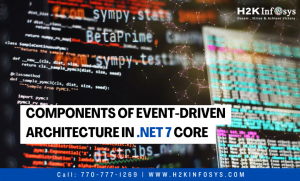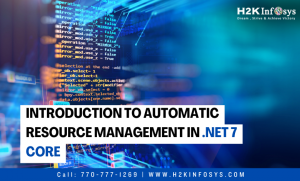Dapr is an open-source, language-neutral, event-driven runtime that helps programmers create scalable, portable, and resilient distributed .NET applications. The underlying infrastructure is managed by Dapr’s runtime, freeing developers to concentrate on creating their applications rather than the infrastructure. Based on the actor model, it facilitates loose coupling between components and increases the resilience of your application in the event of a breakdown.
Cloud-native application development is made easier with Dapr, a distributed application runtime that lets developers concentrate on business logic instead of infrastructure details. Dapr is a great option for creating cloud apps because of a number of its architectural features. To learn more about DAPR, check out the online .NET course.
Sidecar Architecture
Dapr can function in its memory process or container and coexist with your service by employing a sidecar. A sidecar is a backup program that can be launched concurrently with the primary program and operated in parallel, usually as a separate process.
Sidecars can provide isolation and encapsulation without affecting the service itself because they are separate from the service to which they are connected. Because of this isolation, you may write a sidecar on a variety of platforms and programming languages and still allow it to have its own runtime environment.
Why Use Dapr for Building Event-Driven Applications?
Dapr offers developers creating event-driven apps the following advantages:
- Portability: Dapr apps can be installed on any platform, such as Azure Functions, Service Fabric, and Kubernetes.
- Scalability: Dapr’s ability to scale both vertically and horizontally allows applications to be scaled up or down without requiring code modifications.
- Resilience: Dapr’s actor model contributes to the increased resilience of your application against errors. The other components can keep functioning even if one fails, guaranteeing that your program will stay responsive even in the face of difficulty.
- Flexibility: When creating Dapr apps, developers have access to a wide range of programming languages, including as Python, Java, C#, and Node.js.
- Simple YAML file deployment for Dapr apps makes it easy to get started with event-driven programming, which simplifies the process of using Dapr apps.
- Loose coupling: The parts of a Dapr-based application can be developed and implemented separately since they are not tightly coupled. Your application will be easier to maintain and grow over time as a result of being more modular and maintainable.
Dapr Architecture: The Building Blocks of Dapr
Dapr consists of several fundamental components:
- Service-to-service invocation: In charge of making direct, safe, and secure calls to services
- State management: Encourages the development of enduring stateful and stateless programs.
- Publish and subscribe: Offers assistance for safe, scalable communication between the services
- Bindings: This building block’s component that allows external resources to be attached to it in order to start or receive calls from services is known as bindings.
- Actors: Provides reusable actor objects with the logic and information needed to manage state.
- Configuration: Used to make it simple to share modifications to an application’s configuration and to receive alerts when those changes are performed.
- Observability: Measures and tracks message calls made by components, services, and apps that are deployed with a Dapr sidecar.
- Secrets: Provides access to external secret stores in a secure manner.
Using Dapr in Distributed Applications
An excellent match for event-driven architectures is Dapr. Its pub/sub architecture facilitates the decoupling and independent scalability of services. Dapr facilitates communication between services via a pub/sub architecture. This implies that every service has the ability to publish its own events as well as subscribe to events from other services. Dapr’s building blocks offer features like pub/sub messaging, state management, and service-to-service invocation that are typical of distributed systems.
Distributed microservice applications have inherent complexity, which Dapr minimises. Because Dapr is event-driven, it is crucial to the development of microservices-based applications because it allows you to create applications that can rapidly respond to events from other systems and generate events that alert other services to new information.
Let’s now look at how to utilise Dapr to build event-driven applications in ASP.NET 7.
Create a New ASP.NET 7 Project in Visual Studio 2022
There are multiple ways to start a project with Visual Studio 2022. Upon opening Visual Studio 2022, the Start window will appear. To open the Visual Studio 2022 IDE’s main interface, select “Continue without code.”
To start a new Visual Studio 2022 ASP.NET 7 project:
- Launch the IDE for Visual Studio 2022.
- Click Next to proceed after selecting ASP.NET Core Web API in the Create a new project window.
- In the Configure your new project window, enter DaprDemo as the project name and the path where it should be created. You can optionally click the Place solution and project in the same directory checkbox if you would like the solution file and project to be created in the same directory. Click Next to move on.
- Indicate the authentication type and the target framework as .NET 7 (Standard Term Support) on the next screen. Since you won’t be using any of them in this example, make sure the Configure for HTTPS, Enable Docker Support, and Enable OpenAPI support checkboxes are all unchecked.
- Uncheck Use controllers (uncheck to use minimal APIs) since in this example, you’ll be utilising minimal APIs.
- In order to finish the process, click Create.
Conclusion Dapr provides simple-to-use tools that facilitate the creation and implementation of event-driven applications. Dapr’s emphasis on scalability, robustness, and portability makes it a great option for developers who want to use .NET Core to create dependable, scalable, and distributed applications. Check out the .NET online training to learn more.










